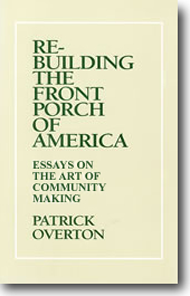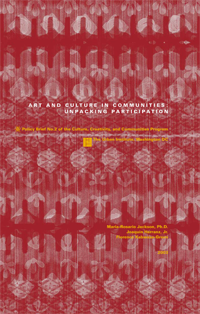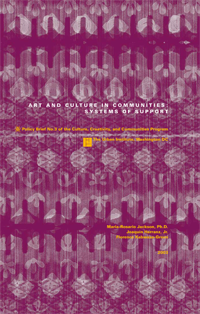Public Agency
Public Agency
We may go to the opera, live theater, or the symphony, but we don't stop to really think about how much these performances can mean to our daily lives and to our communities. Those performing arts organizations have been concentrating on this issue for years.
Read More...This report focuses on two issues: (1) the usefulness of existing arts and culture data for the purposes of developing neighborhood indicators and (2) the ways in which art and culture are understood and valued at the neighborhood level by those who live and work there. Included are a discussion of the reconnaissance efforts, field work, workshops, pilot and case studies conducted; a review of existing arts and culture data collection practices and their usefulness for developing neighborhood indicators; and an analytical framework for identifying indicator types.
Read More...2010, 12 pages, The Urban Institute, 2100 M Street NW, Washington, D.C., 20037, (202) 833-7200 http://www.urban.org
Download:
Read More...2010, 72 pages, The Urban Institute, 2100 M Street NW, Washington, D.C., 20037, (202) 833-7200 http://www.urban.org
Download:
Read More...A report from the 1994 arts education conference of Americans for the Arts co-founding organization, the American Council for the Arts. As stated in the introduction, "The historical relationship between business and the arts has been governed by a single set of terms. The arts—and arts education—have looked to the private sector for financial support and patronage, and business has looked to the arts to enrich the lives of their employees and of the community, but not for any strictly business benefit.
Read More...This pamphlet presents statistical, case study, and concluding material about at-risk youth arts programs in cities across the US. Citing encouraging results from more than a dozen programs, this resource shows how arts programming is being effectively used to address the problems of youth. It also reviews the issue of funding, spotlighting programs that operate as partnerships between local, state, and government agencies and arts organizations. A "how-to" section outlines specific steps to follow in planning programs, and a two-page resource list gives information on related titles.
Read More...
This important new study, released in June 2002, demonstrates conclusively that the nonprofit arts industry has a significant economic impact on local and national economies. And, for the first time, in addition to spending by arts organizations, information has been gathered on event-related spending by arts audiences. Americans for the Arts worked with 91 community partners from across the U.S. to collect expenditure data for this study.
Read More...
This book takes a fresh and positive approach to understanding the arts as essential for creating authentic and sustained community. While it focuses on development in rural and small communities, it is an inspiration for individuals and organizations large and small.
160pp, paperback (1997, PrairieSea Press)
Read More...The president and CEO of Rockefeller Philanthropy Advisors discusses what's on the minds of the people who control philanthropy's purse strings.
Available free online from Stanford Social Innovation Review.
Download:
![]() 15 Minutes with Melissa Berman (238Kb)
15 Minutes with Melissa Berman (238Kb)
This article looks at the delicate relationship between non-profits and donors. It stresses the responsibility for honest and efficient communication and examines a new breed of donors who consider themselves investors and seek much more information in the non profits they fund.
Available free from the Stanford Social Innovation Review.
Read More...

